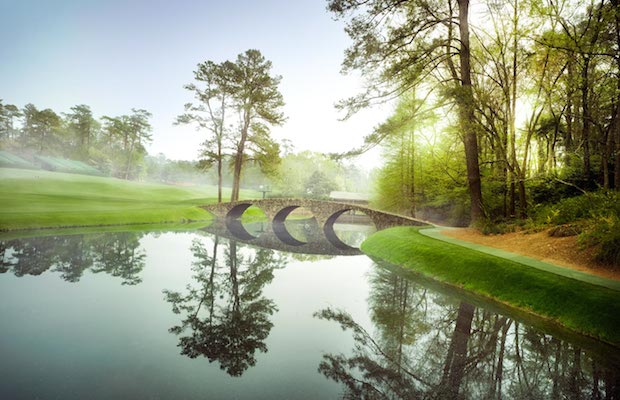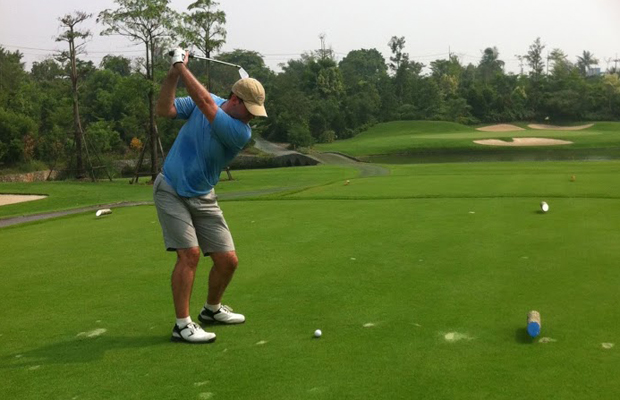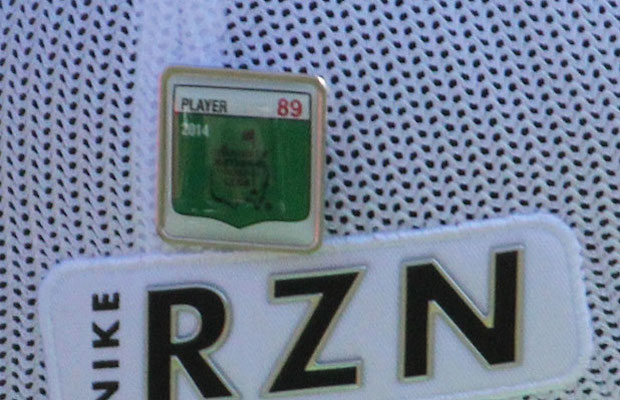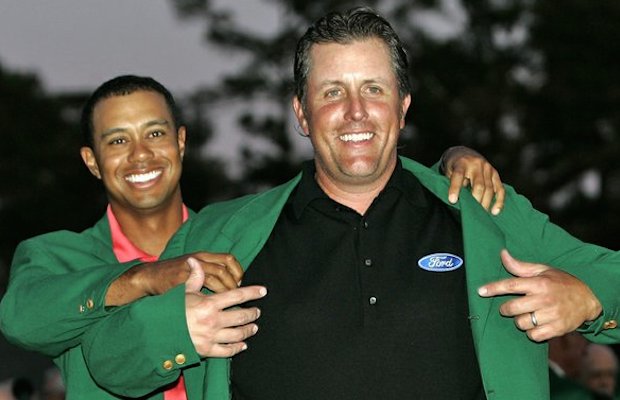Opinion & Analysis
The Masters gets it right

No matter what happens on the back nine of Sunday at the Masters, viewers are left with a lasting image and a memory that is unique from golf’s three other major championships. While Sunday’s rendition of Augusta’s back nine might have fell short of expectations in the drama department, with Bubba Watson holding onto a three-shot lead from the 12th hole until the finish line, what happened during yesterday afternoon at the Masters will most definitely leave a lasting impression on golf in the years to come.
Golf fans witnessed 20-year old Jordan Spieth prove to the world that his name will be seen on major championship leaderboards soon again and quite often. His tenacity and knack for competition at an early age is something for which golf fans have yearned, and his appetite for winning only could have grown stronger after yesterday’s defeat. We also watched Bubba Watson cure his 2012 Green Jacket hangover by showing yet again that “Bubba-Golf” might just be the Masters fields’ biggest enemy.
Yes, the unique feeling that golf fans share with regards to the Masters has plenty to do with how it is the only major played on the same course every year, but there’s more to it than that. The images and the memories that we are left with, in my opinion, are not necessarily a result of the iconic golf shots that have resulted in Green Jacket glory over the years, but from the countless “perfect” details about the course and the tournament in general that create the stage for such shots to stand out in our minds. To sum it up, come Sunday evening in mid–April, the Masters always wins.
After receiving an envelope in the mail from the Masters Tournament in the late fall with a pair tickets to Wednesday’s practice rounds, I would get the opportunity to uncover all of the mystique, the expectation and the “perfection” I had been hearing, dreaming and probably talking about way too much for the last decade.
One of the things a patron will notice about Augusta National for the first time is the immense size of the property. From the recently constructed practice facility (which I will discuss below), to the par-3 course and the concession and merchandise areas, the landscape of the Augusta National property is gigantic. While the property is so grand, spectators will also notice that the actual golf course — from the 1st tee to the 18th green — is actually very close together, and here’s why.
When Bobby Jones and Clifford Roberts embarked upon this landscape in Augusta, Ga., in 1930, their intention was not to just build a golf course, which one could argue was the intention of maybe every other course ever constructed in the world. They settled on this property with the goal of creating a tournament and spectacle. It’s almost as if Jones and Roberts had the ability to look into the future to 2005; when Tiger holed out from the left fringe on No. 16, or in 2010 when Phil struck his 6 iron out of the pine-straw to establish the courses most influential holes coming down the stretch in area of the property where the noise and reaction of the crowd would radiate in a amphitheater, manufacturing a noise and a creating a buzz that could not be matched in this sport.
While standing at the practice green situated right in front of the clubhouse, which looks out over the entire golf course, I could hear patron’s chant “skip it, skip it” as players participated in the 16th hole practice round tradition of skipping it over the water onto the green. I could only imagine the sounds a Sunday roar could create, as the ones I witnessed on a Wednesday managed to send chills down my spine.
Another aspect of perfection and genius that caught my eye, which I don’t think many others would have picked up on, was on the practice facility, and I emphasize the word practice. First, I think I can answer this question for all of you… have you ever been on a driving range where there isn’t a green as a target at the very end for your longest club? I am 99.9 percent sure that the answer is no, but if you have then please say so!
At the Augusta National range, the farthest green from the tees is about 230 yards away. Beyond this green are clump of trees separating the range into a Y shape, creating two separate fairways. While watching players hitting drivers and 3 woods to both to the right and left sides of the range, a light bulb went off in my head and I yelled out loud to my dad, “It makes perfect sense!” How often in a round do you hit a tee ball that isn’t on a par-3 to a green? The answer is never, unless it’s a drivable par-4.
The end of the range is set up so that you practice hitting tee balls to locations similar to the course. There is also a set of fairway bunkers along the right side of the range at the 300-yard distance, so players can practice hitting a tee ball in between a set of trees and a set of bunkers, just like on the course. It actually makes so much sense and it’s really quite simple when you think about, but still, Augusta National is the only place that I’ve seen it done.
While I believe Augusta National’s decision to allow female members to the club was one that could have come a decade or so earlier, I will finish off by alluding to what might turn out to be the most impactful decisions the Masters committee has made in recent years with regards to the growth of the game. Last year, Masters Chairman Billy Payne announced the finals for the Drive, Chip, and Putt competition – a golf skills contest in America for girls and boys ages 7-to-15 – would be hosted at Augusta National.
While much wasn’t made of such a decision at first, the televised coverage of the event created a stir among golf’s leading influencers that was centered around the overwhelming positive impression the initiative will have on the game. For those kids who didn’t qualify or didn’t even attempt to be the first Drive, Chip and Putt contestants to hit golf shots on the course, I’m sure that after seeing Bubba Watson and Jordan Spieth fist pumping and high fiving all the participants has driven hundreds of thousands of young kids to want to work harder, or even pick up the game in order to have that opportunity next year and in the years to come. The impact that a little detail like having the 2013 Masters Champion, Adam Scott, hand out the trophies to the competitions winners may have made this initiative and this new Masters traditions one of the best one’s since the clubs inception.
In recent years, the Masters Committee has also established its roots internationally, inviting the winners of amateur events in Asia and South America to play in the Masters. The growth of the game, or lack there of, is a much-debated topic in golf. While I don’t believe it is the responsibility of the Masters Tournament and the Augusta National Golf Club to fix whatever issues the game might face, the fine men in their Green Jackets do in fact realize and utilize the influence their club and their tournament has on the game.
The decisions they make — from where they place the greens on the practice facility, the $1.50 sandwiches and growing the game in fast-growing continents around the world — are always the right ones and seem to have impacted the game of golf in the highest regard.
- LIKE0
- LEGIT0
- WOW0
- LOL0
- IDHT0
- FLOP1
- OB0
- SHANK0
19th Hole
Vincenzi’s 2024 Zurich Classic of New Orleans betting preview

The PGA TOUR heads to New Orleans to play the 2023 Zurich Classic of New Orleans. In a welcome change from the usual stroke play, the Zurich Classic is a team event. On Thursday and Saturday, the teams play best ball, and on Friday and Sunday the teams play alternate shot.
TPC Louisiana is a par 72 that measures 7,425 yards. The course features some short par 4s and plenty of water and bunkers, which makes for a lot of exciting risk/reward scenarios for competitors. Pete Dye designed the course in 2004 specifically for the Zurich Classic, although the event didn’t make its debut until 2007 because of Hurricane Katrina.
Coming off of the Masters and a signature event in consecutive weeks, the field this week is a step down, and understandably so. Many of the world’s top players will be using this time to rest after a busy stretch.
However, there are some interesting teams this season with some stars making surprise appearances in the team event. Some notable teams include Patrick Cantlay and Xander Schauffele, Rory McIlroy and Shane Lowry, Collin Morikawa and Kurt Kitayama, Will Zalatoris and Sahith Theegala as well as a few Canadian teams, Nick Taylor and Adam Hadwin and Taylor Pendrith and Corey Conners.
Past Winners at TPC Louisiana
- 2023: Riley/Hardy (-30)
- 2022: Cantlay/Schauffele (-29)
- 2021: Leishman/Smith (-20)
- 2019: Palmer/Rahm (-26)
- 2018: Horschel/Piercy (-22)
- 2017: Blixt/Smith (-27)
2024 Zurich Classic of New Orleans Picks
Tom Hoge/Maverick McNealy +2500 (DraftKings)
Tom Hoge is coming off of a solid T18 finish at the RBC Heritage and finished T13 at last year’s Zurich Classic alongside Harris English.
This season, Hoge is having one of his best years on Tour in terms of Strokes Gained: Approach. In his last 24 rounds, the only player to top him on the category is Scottie Scheffler. Hoge has been solid on Pete Dye designs, ranking 28th in the field over his past 36 rounds.
McNealy is also having a solid season. He’s finished T6 at the Waste Management Phoenix Open and T9 at the PLAYERS Championship. He recently started working with world renowned swing coach, Butch Harmon, and its seemingly paid dividends in 2024.
Keith Mitchell/Joel Dahmen +4000 (DraftKings)
Keith Mitchell is having a fantastic season, finishing in the top-20 of five of his past seven starts on Tour. Most recently, Mitchell finished T14 at the Valero Texas Open and gained a whopping 6.0 strokes off the tee. He finished 6th at last year’s Zurich Classic.
Joel Dahmen is having a resurgent year and has been dialed in with his irons. He also has a T11 finish at the PLAYERS Championship at TPC Sawgrass which is another Pete Dye track. With Mitchell’s length and Dahmen’s ability to put it close with his short irons, the Mitchell/Dahmen combination will be dangerous this week.
Taylor Moore/Matt NeSmith +6500 (DraftKings)
Taylor Moore has quickly developed into one of the more consistent players on Tour. He’s finished in the top-20 in three of his past four starts, including a very impressive showing at The Masters, finishing T20. He’s also finished T4 at this event in consecutive seasons alongside Matt NeSmith.
NeSmith isn’t having a great 2024, but has seemed to elevate his game in this format. He finished T26 at Pete Dye’s TPC Sawgrass, which gives the 30-year-old something to build off of. NeSmith is also a great putter on Bermudagrass, which could help elevate Moore’s ball striking prowess.
- LIKE8
- LEGIT3
- WOW1
- LOL1
- IDHT0
- FLOP3
- OB1
- SHANK1
19th Hole
Vincenzi’s 2024 LIV Adelaide betting preview: Cam Smith ready for big week down under

After having four of the top twelve players on the leaderboard at The Masters, LIV Golf is set for their fifth event of the season: LIV Adelaide.
For both LIV fans and golf fans in Australia, LIV Adelaide is one of the most anticipated events of the year. With 35,000 people expected to attend each day of the tournament, the Grange Golf Club will be crawling with fans who are passionate about the sport of golf. The 12th hole, better known as “the watering hole”, is sure to have the rowdiest of the fans cheering after a long day of drinking some Leishman Lager.
The Grange Golf Club is a par-72 that measures 6,946 yards. The course features minimal resistance, as golfers went extremely low last season. In 2023, Talor Gooch shot consecutive rounds of 62 on Thursday and Friday, giving himself a gigantic cushion heading into championship Sunday. Things got tight for a while, but in the end, the Oklahoma State product was able to hold off The Crushers’ Anirban Lahiri for a three-shot victory.
The Four Aces won the team competition with the Range Goats finishing second.
*All Images Courtesy of LIV Golf*
Past Winners at LIV Adelaide
- 2023: Talor Gooch (-19)
Stat Leaders Through LIV Miami
Green in Regulation
- Richard Bland
- Jon Rahm
- Paul Casey
Fairways Hit
- Abraham Ancer
- Graeme McDowell
- Henrik Stenson
Driving Distance
- Bryson DeChambeau
- Joaquin Niemann
- Dean Burmester
Putting
- Cameron Smith
- Louis Oosthuizen
- Matt Jones
2024 LIV Adelaide Picks
Cameron Smith +1400 (DraftKings)
When I pulled up the odds for LIV Adelaide, I was more than a little surprised to see multiple golfers listed ahead of Cameron Smith on the betting board. A few starts ago, Cam finished runner-up at LIV Hong Kong, which is a golf course that absolutely suits his eye. Augusta National in another course that Smith could roll out of bed and finish in the top-ten at, and he did so two weeks ago at The Masters, finishing T6.
At Augusta, he gained strokes on the field on approach, off the tee (slightly), and of course, around the green and putting. Smith able to get in the mix at a major championship despite coming into the week feeling under the weather tells me that his game is once again rounding into form.
The Grange Golf Club is another course that undoubtedly suits the Australian. Smith is obviously incredibly comfortable playing in front of the Aussie faithful and has won three Australian PGA Championship’s. The course is very short and will allow Smith to play conservative off the tee, mitigating his most glaring weakness. With birdies available all over the golf course, there’s a chance the event turns into a putting contest, and there’s no one on the planet I’d rather have in one of those than Cam Smith.

Louis Oosthuizen +2200 (DraftKings)
Louis Oosthuizen has simply been one of the best players on LIV in the 2024 seas0n. The South African has finished in the top-10 on the LIV leaderboard in three of his five starts, with his best coming in Jeddah, where he finished T2. Perhaps more impressively, Oosthuizen finished T7 at LIV Miami, which took place at Doral’s “Blue Monster”, an absolutely massive golf course. Given that Louis is on the shorter side in terms of distance off the tee, his ability to play well in Miami shows how dialed he is with the irons this season.
In addition to the LIV finishes, Oosthuizen won back-to-back starts on the DP World Tour in December at the Alfred Dunhill Championship and the Mauritus Open. He also finished runner-up at the end of February in the International Series Oman. The 41-year-old has been one of the most consistent performers of 2024, regardless of tour.
For the season, Louis ranks 4th on LIV in birdies made, T9 in fairways hit and first in putting. He ranks 32nd in driving distance, but that won’t be an issue at this short course. Last season, he finished T11 at the event, but was in decent position going into the final round but fell back after shooting 70 while the rest of the field went low. This season, Oosthuizen comes into the event in peak form, and the course should be a perfect fit for his smooth swing and hot putter this week.

- LIKE12
- LEGIT3
- WOW1
- LOL1
- IDHT0
- FLOP1
- OB1
- SHANK1
Opinion & Analysis
The Wedge Guy: What really makes a wedge work? Part 1

Of all the clubs in our bags, wedges are almost always the simplest in construction and, therefore, the easiest to analyze what might make one work differently from another if you know what to look for.
Wedges are a lot less mysterious than drivers, of course, as the major brands are working with a lot of “pixie dust” inside these modern marvels. That’s carrying over more to irons now, with so many new models featuring internal multi-material technologies, and almost all of them having a “badge” or insert in the back to allow more complex graphics while hiding the actual distribution of mass.
But when it comes to wedges, most on the market today are still single pieces of molded steel, either cast or forged into that shape. So, if you look closely at where the mass is distributed, it’s pretty clear how that wedge is going to perform.
To start, because of their wider soles, the majority of the mass of almost any wedge is along the bottom third of the clubhead. So, the best wedge shots are always those hit between the 2nd and 5th grooves so that more mass is directly behind that impact. Elite tour professionals practice incessantly to learn to do that consistently, wearing out a spot about the size of a penny right there. If impact moves higher than that, the face is dramatically thinner, so smash factor is compromised significantly, which reduces the overall distance the ball will fly.
Every one of us, tour players included, knows that maddening shot that we feel a bit high on the face and it doesn’t go anywhere, it’s not your fault.
If your wedges show a wear pattern the size of a silver dollar, and centered above the 3rd or 4th groove, you are not getting anywhere near the same performance from shot to shot. Robot testing proves impact even two to three grooves higher in the face can cause distance loss of up to 35 to 55 feet with modern ‘tour design’ wedges.
In addition, as impact moves above the center of mass, the golf club principle of gear effect causes the ball to fly higher with less spin. Think of modern drivers for a minute. The “holy grail” of driving is high launch and low spin, and the driver engineers are pulling out all stops to get the mass as low in the clubhead as possible to optimize this combination.
Where is all the mass in your wedges? Low. So, disregarding the higher lofts, wedges “want” to launch the ball high with low spin – exactly the opposite of what good wedge play requires penetrating ball flight with high spin.
While almost all major brand wedges have begun putting a tiny bit more thickness in the top portion of the clubhead, conventional and modern ‘tour design’ wedges perform pretty much like they always have. Elite players learn to hit those crisp, spinny penetrating wedge shots by spending lots of practice time learning to consistently make contact low in the face.
So, what about grooves and face texture?
Grooves on any club can only do so much, and no one has any material advantage here. The USGA tightly defines what we manufacturers can do with grooves and face texture, and modern manufacturing techniques allow all of us to push those limits ever closer. And we all do. End of story.
Then there’s the topic of bounce and grinds, the most complex and confusing part of the wedge formula. Many top brands offer a complex array of sole configurations, all of them admittedly specialized to a particular kind of lie or turf conditions, and/or a particular divot pattern.
But if you don’t play the same turf all the time, and make the same size divot on every swing, how would you ever figure this out?
The only way is to take any wedge you are considering and play it a few rounds, hitting all the shots you face and observing the results. There’s simply no other way.
So, hopefully this will inspire a lively conversation in our comments section, and I’ll chime in to answer any questions you might have.
And next week, I’ll dive into the rest of the wedge formula. Yes, shafts, grips and specifications are essential, too.
- LIKE32
- LEGIT7
- WOW1
- LOL1
- IDHT2
- FLOP3
- OB1
- SHANK3
-

 19th Hole2 weeks ago
19th Hole2 weeks agoDave Portnoy places monstrous outright bet for the 2024 Masters
-

 19th Hole3 days ago
19th Hole3 days agoJustin Thomas on the equipment choice of Scottie Scheffler that he thinks is ‘weird’
-

 19th Hole2 weeks ago
19th Hole2 weeks agoTiger Woods arrives at 2024 Masters equipped with a putter that may surprise you
-

 19th Hole3 days ago
19th Hole3 days ago‘Absolutely crazy’ – Major champ lays into Patrick Cantlay over his decision on final hole of RBC Heritage
-

 19th Hole3 weeks ago
19th Hole3 weeks agoReport: Tiger Woods has ‘eliminated sex’ in preparation for the 2024 Masters
-

 19th Hole1 week ago
19th Hole1 week agoTwo star names reportedly blanked Jon Rahm all week at the Masters
-

 19th Hole1 week ago
19th Hole1 week agoReport: LIV Golf identifies latest star name they hope to sign to breakaway tour
-

 19th Hole1 week ago
19th Hole1 week agoNeal Shipley presser ends in awkward fashion after reporter claims Tiger handed him note on 8th fairway






















BallBuster
Apr 16, 2014 at 1:04 pm
I don’t think the Masters got it right in recent years and what seems to be their future course. I’m losing interest in the Sunday round at Augusta. There won’t be anymore back 9 charges like Jack had in 86. I doubt there will be many late birdie rallies like O’Meara had several years ago to steal a win.
Bubba did what one has to do anymore. Just hang on. It will be in the leader’s hands. Rory was an example of going cold and losing the lead. Someone may shoot a 69 to make a “move”, but unless the leader throws away shots, it’s a slow march that other will have a very hard time overcoming. I liked the old days better. Making moves up the leaderboard and the roars of the crowd.
The average winner’s score form the last 15 years since the Tiger-proofing began is just over 69 in the final round. Couple that with the fact the winner has come from that last group over 80% of the time means that as long as you shoot OK, no one can charge past you unlike many times in the past. The worst is Trevor Immelman shooting a 75 and no one could still come within 3 strokes. Boring.
Philip
Apr 16, 2014 at 3:00 pm
what about bubba birdieing 13-16 in the final round in 2012 to force a playoff and schwartzel birdieing the final 4 holes in 2011 to win outright? that not enough of a “charge”?
Ed
Apr 16, 2014 at 12:08 pm
I dunno. I still don’t like the way they did the coverage on ESPN. It was awful.
Ryan
Apr 15, 2014 at 2:17 pm
great article